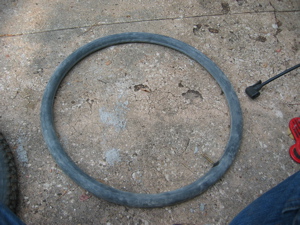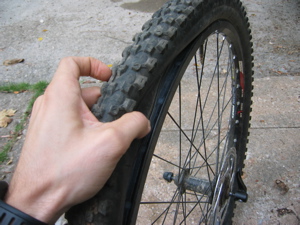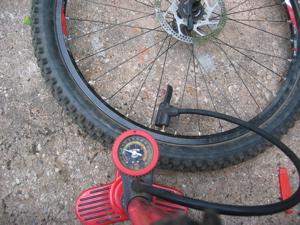Whether you’re on the trail or in your driveway, it’s no big deal to fix a flat mountain bike tire. In the ideal situation, all you need is a pump, tire levers, and a new tube.
If your tire still has some air pressure left in it, release the air by pressing in on the tire valve. Depending on the type of valve your tire has, you may need to unscrew the pressure release or use your fingernail to press the release valve.
Next, pull the tire away from the rim. You may need to use your tire lever to get the tire started, once it’s out you can trace around the rim to quickly remove one side of the tire. Repeat the process for the other side of the tire wall. Don’t forget to remove the screw locking ring if your tubes have one.
Remove the tire and tube from the rim. Check the rim to make sure there isn’t anything ganky on the rim that could have caused your flat. Pay particular attention to the rim tape covering spoke connections inside the rim and replace as necessary. Run your hand through the tire itself to check for thorns or other sharp objects. If something causes you to bleed there’s a good chance that it’ll pierce your tire as well.
Now you’re ready to start putting things back together. Inflate your new tube with just enough air to give it some shape. This will help you place it in the tire easily. Place the tube completely inside the tire like a hot dog in a bun. Find the valve hole on your wheel and place the valve stem in the hole.
Start working one side of the tire onto the rim. You should be able to use your hands for most of it, once you’ve made your way around most of the tire you may need to use your levers to pop the tire wall bead inside the rim. Repeat for the other side (note: the second side may be more difficult than the first, especially for tight fitting tires).
Before you begin inflating your tire it’s important to make sure the tube isn’t pinched between the rim and the tire (called a pinch flat). Start at a known point on the tire (I usually start at the valve) and work your way around the tire looking for pinches. When you get back to your start point, flip the tire and check the other side all the way around.
Now you’re ready for the fun part: pumping. Inflate your tire to a reasonable pressure. My pump has a gauge that’s marked for different types of bike tires. It recommends 30-60 psi for mountain bike tires but it’s really up to you. If you like a squishy ride or you like to use your tires as a poor man’s suspension, keep the pressure low. If you’re riding hardpack you may want to go for a higher pressure which will help you go faster. I personally prefer staying at the high end of the range because I’ve found that I get fewer flats on the trail at higher pressures.


























